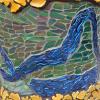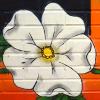Emerging Artists From Lamar Dodd: Annual MFA Show Expands to Two Venues
Art Notes

Sydney Daniel at the Georgia Museum of Art
Dating back to a friendship between artist Lamar Dodd, the namesake of UGA’s art school, and Alfred Holbrook, founder of the Georgia Museum of Art in the 1940s, the annual “Master of Fine Arts Degree Candidates Exhibition” represents the culmination of each graduate’s three-year journey towards a terminal degree and transition into the professional art world.
Unlike in the past, this year’s candidates have been divided between two venues: the art museum on campus and the Deupree Building downtown on Clayton Street. While better at accommodating large-scale and installation-based works, the expansion to a second location reflects an objective of the art school’s five-year plan: creating a downtown presence through a gallery or workspace in order to support the larger goal of enhancing its reputation and visibility both locally and globally.
Up until this year, candidates have always declared a clear concentration—ceramics, drawing and painting, fabric design, interior design, jewelry and metalwork, photography and video, printmaking and book arts, or sculpture. While students are still free to dedicate themselves to one primary focus, a shift in the school’s approach has increased the curriculum’s flexibility to accommodate more interdisciplinary research and experimentation across media.
Dimelza Broche’s “Reinventing Venus/Rebirth of Venus” is dazzling in its delicacy and hand-embroidered pearls. A plaster cast of a woman’s torso—presumably modeled after the artist’s—reclines on a floor of mirrors, legs transforming into wool felt just above the knee, then noodling into an inexplicable knot of plaster feet posed in every direction. In her artist statement, Broche describes living with a genetic illness has been a driving force behind her work, and how creating artwork offers a way to understand her body in a new context. In a culture where it’s considered rude to stare, Broche’s installation includes two faux-fur-covered stools that invite the viewer to sit down and take a long, hard look at how beautiful a differently abled body is.
Broche happens to be a very talented painter, as well, and luckily, if you keep a determined eye out, you can find one of her miniature paintings depicting a lush, mossy fantasy scene tucked away inside of “Hell Is Other People,” by Justin Barker. Drawing inspiration from doll houses and suburbia, his construction consists of a row of tiny pink houses with white picket fences that have all been digitally designed, laser cut and screen printed—a process that reflects mass production and the influence of globalization on small communities. Each house has a peephole the viewer can look through to observe an interesting three-dimensional scene. Barker’s other diorama, “Mustang Lounge,” is a bar and restaurant—complete with teeny glasses of beer, ketchup bottles and a dart board—that further plays with the viewer’s perception of scale, location and the passage of time by projecting a video taken from inside the lounge.
Similarly experimenting with scale, Sydney Daniel’s mixed-media series of prints appear like giant Polaroid photographs suspended from the ceiling. She photographs candid portraits using Polaroid film that has been expired for close to a decade, allowing its compromised, unpredictable quality to determine the color, exposure and overall integrity of each shot. In many of the photographs, only fractions of the original image survive, reflecting Daniel’s interest in the degradation of memories over time. Each photograph is then sewn over, representing the mind’s attempt at recalling and modifying memories.
Several of the artists present bodies of work with foundations influenced by their personal upbringing and cultural heritage, such as Guadalupe Navarro, who, growing up in a first-generation Mexican-American household, seeks to create a positive portrait of Mexican culture. His work “Essential/Non Essential” is a series of small brass objects that are frequently left behind or confiscated at the Mexican/U.S. border, such as IDs, lighters, combs, toys, toiletries and bibles. While considered essential for survival by immigrants, they are viewed as non-essential by officials. Because all of these items are typically carried on the body, Navarro created the brass pieces as wearable jewelry forms that are given new importance by placing them back on the body.
Artists showing works at the Georgia Museum include Dimelza Broche, Catherine Chang, Sydney Daniel, Sanaz Haghani, Yiran Liu, Esther Lee Mech, Guadalupe Navarro and Jennifer Niswonger. Additional artists at the Deupree Building include Justin Barker, Amanda Britton, Shawn Campbell, Catherine Clements, Lindy Erkes, Yusheng Fang, Matthew Flores, William Major, Kimberly McWhorter, Lauren O’Connor-Korb, Paula Runyon and Taylor Shaw.
The Deupree Building, located at 458 E. Clayton St. in the former Junkman’s Daughter space, is open to the public Fridays and Saturdays from 11 a.m.–5 p.m. Both exhibitions will remain on view through Sunday, May 19.
More by Jessica Smith
-

Art Around Town
A list of local art exhibits.
-

-

Art Around Town
A list of local art exhibits.









comments